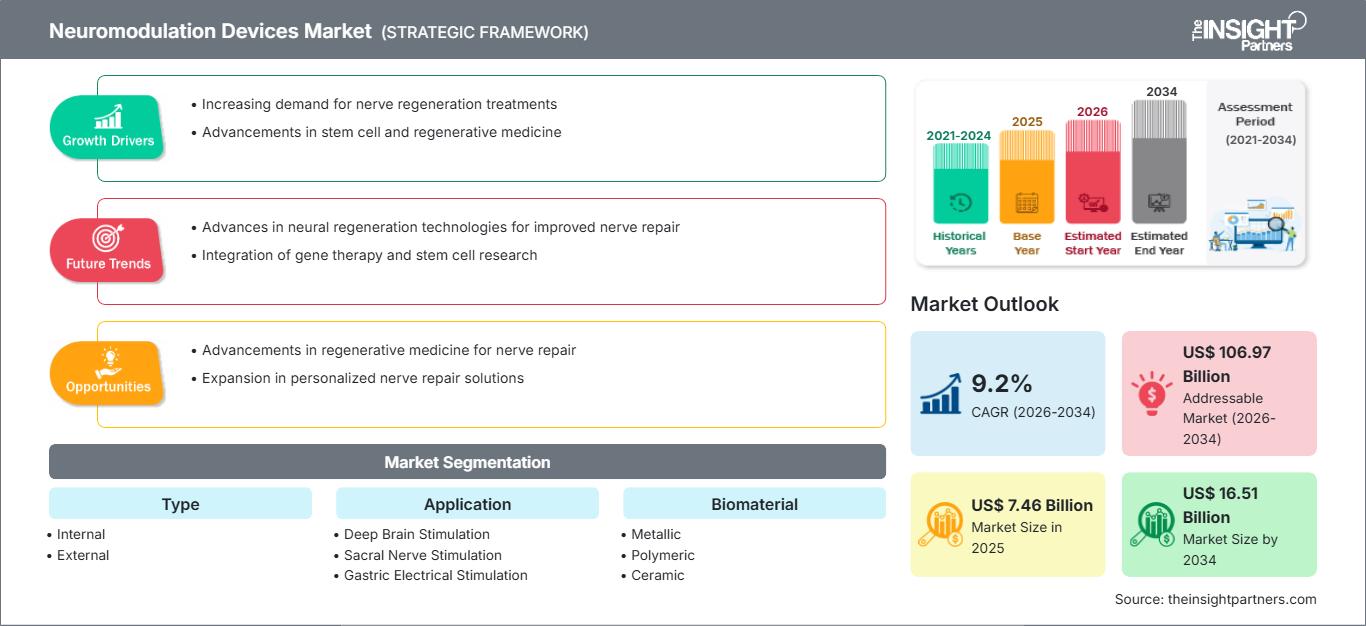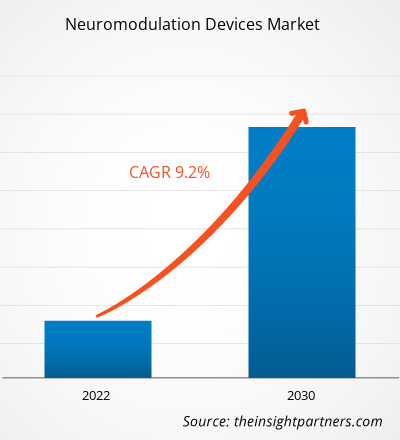Il mercato dei dispositivi di neuromodulazione, valutato a 7,46 miliardi di dollari nel 2025, dovrebbe raggiungere i 16,51 miliardi di dollari entro il 2034, con un CAGR del 9,2% nel periodo 2026-2034. Le condizioni di mercato continuano a evolversi, aprendo nuove opportunità per gli stakeholder. Il panorama generale riflette un progresso stabile e un potenziale di crescita a lungo termine.
L'uso della neuromodulazione è in rapida crescita, con un'ampia gamma di metodi impiantabili e non invasivi basati su tecnologie per il trattamento di disturbi neuropsichiatrici e neurologici. Terapie come la stimolazione corticale intracranica (ICS), la stimolazione magnetica transcranica (TMS), la stimolazione cerebrale profonda (DBS) e la stimolazione transcranica a corrente continua (tDCS) hanno mostrato risultati promettenti in una vasta gamma di disturbi neuropsichiatrici e neurologici. I dispositivi di neuromodulazione sono strumenti medici avanzati in grado di regolare l'attività del sistema nervoso. La tecnologia viene utilizzata per trattare disturbi del movimento come distonia, morbo di Parkinson, tremori, acufeni, disturbi ossessivo-compulsivi, disabilità sensoriali, epilessia, controllo della vescica, cefalea, dolore cronico, ictus, stato di minima coscienza, spasticità e lesioni del midollo spinale. Fattori come l'aumento dei casi di lesioni del midollo spinale e la crescente prevalenza di disturbi neurologici contribuiscono alla crescita del mercato dei dispositivi di neuromodulazione.
Fattori trainanti del mercato:
La popolazione geriatrica è suscettibile alle malattie neurologiche. I disturbi neurologici più comuni che colpiscono gli anziani sono la neuropatia, il morbo di Parkinson, il morbo di Alzheimer, la distonia e altri. Secondo il Dipartimento degli Affari Economici e Sociali delle Nazioni Unite, nel 2022, a livello globale c'erano 771 milioni di persone di età pari o superiore a 65 anni. Si prevede che la popolazione anziana raggiungerà i 994 milioni entro il 2034 e 1.600 milioni entro il 2050. Paesi come gli Stati Uniti e il Canada presentano alti tassi di prevalenza di disturbi del movimento e disturbi psichiatrici associati alla crescita della popolazione geriatrica. Secondo la Parkinson's Foundation, i sintomi del Parkinson sono comuni a un'età media di 60 anni.
La Canadian Psychological Association afferma che il disturbo ossessivo-compulsivo (DOC) colpisce circa il 2% della popolazione canadese. L'Organizzazione Mondiale della Sanità (OMS) afferma che l'epilessia è un disturbo neurologico che causa crisi epilettiche e colpisce circa 50 milioni di persone in tutto il mondo. Secondo l'American Academy of Neurology, l'ictus è la terza causa di morte negli Stati Uniti, seguito dall'Alzheimer come sesta causa di morte. Le statistiche della stessa fonte mostrano che quasi un milione di americani è affetto dal morbo di Parkinson e che ogni anno vengono segnalati almeno 60.000 nuovi casi. La crescente prevalenza di malattie neurologiche, associata a disturbi legati allo stile di vita come la depressione e il dolore cronico, porta alla crescente adozione di prodotti tecnologicamente avanzati.
Pertanto, la crescente popolazione geriatrica soggetta a malattie neurologiche, la crescente prevalenza di queste patologie e la crescente consapevolezza dell'enorme peso dei disturbi neurologici determinano la crescita del mercato dei dispositivi di neuromodulazione.
Le neuroscienze si concentrano sul trattamento di disturbi come ictus, cefalea, sclerosi multipla e altri casi gravi. Negli ultimi anni, si è osservata una relativa carenza di personale neurologico qualificato anche nei paesi sviluppati. Negli Stati Uniti ci sono oltre 5.700 ospedali; tuttavia, questi ospedali hanno meno di 3.700 neurochirurghi. Un fattore importante responsabile dell'inadeguatezza della forza lavoro neurochirurgica è l'incapacità di formare neurochirurghi adeguatamente formati in tempi adeguati. Nelle aree urbane sono disponibili strutture neurologiche con tecnologie avanzate. Tuttavia, nelle aree rurali, i trattamenti offerti sono limitati a causa della carenza di professionisti esperti. Pertanto, la carenza di neurochirurghi qualificati ostacola la crescita del mercato dei dispositivi di neuromodulazione.
Personalizza questo report in base alle tue esigenze
Riceverai la personalizzazione gratuita di qualsiasi report, incluse parti di questo report, analisi a livello nazionale, pacchetto dati Excel e potrai usufruire di fantastiche offerte e sconti per start-up e università.
Mercato dei dispositivi di neuromodulazione: approfondimenti strategici

-
Scopri le principali tendenze di mercato di questo rapporto.Questo campione GRATUITO includerà analisi dei dati, che spaziano dalle tendenze di mercato alle stime e alle previsioni.
Segmentazione e ambito del report:
L'analisi di mercato dei dispositivi di neuromodulazione è stata condotta prendendo in considerazione i segmenti: tipo, applicazione, biomateriale e utente finale.
Analisi segmentale:
Il mercato dei dispositivi di neuromodulazione, per tipologia, è suddiviso in esterno e interno. Il segmento della neuromodulazione interna ha detenuto una quota di mercato maggiore nel 2022. Tuttavia, è probabile che il segmento della neuromodulazione esterna registri un CAGR più elevato nel periodo 2022-2030. Il termine "neuromodulazione interna" descrive l'uso di dispositivi medici che forniscono stimolazione elettrica, chimica o di altro tipo a specifici bersagli neuronali al fine di modulare o alterare l'attività del sistema nervoso. Questa tecnica è utilizzata per trattare malattie neurovascolari, anomalie del movimento, epilessia, dolore cronico e incontinenza fecale e urinaria.
In base all'utente finale, il mercato dei dispositivi di neuromodulazione è segmentato in ospedali, cliniche e assistenza domiciliare. Nel 2022, il segmento ospedaliero ha dominato la quota di mercato dei dispositivi di neuromodulazione. A causa dell'espansione di numerosi ospedali e cliniche e dell'aumento della spesa pubblica per la costruzione di infrastrutture sanitarie, il segmento ospedaliero attualmente domina il mercato. Inoltre, si prevede che l'invecchiamento della popolazione si tradurrà in una maggiore prevalenza di dolore cronico, aumentando la domanda di dispositivi di neuromodulazione negli ospedali.
Analisi regionale:
L'ambito del rapporto di mercato sui dispositivi di neuromodulazione è principalmente suddiviso in Nord America (Stati Uniti, Canada e Messico), Europa (Spagna, Regno Unito, Germania, Francia, Italia e resto d'Europa), Asia Pacifico (Corea del Sud, Cina, India, Giappone, Australia e resto dell'Asia Pacifico), Medio Oriente e Africa (Sudafrica, Arabia Saudita, Emirati Arabi Uniti e resto del Medio Oriente e dell'Africa) e Sud e Centro America (Brasile, Argentina e resto del Sud e Centro America).
In termini di fatturato, nel 2022 il Nord America ha dominato la quota di mercato dei dispositivi di neuromodulazione. La crescente prevalenza di malattie neurologiche, l'elevata spesa in ricerca e sviluppo, il crescente numero di approvazioni di prodotti da parte della FDA e i progressi tecnologici aumentano la domanda di dispositivi di neuromodulazione nella regione.
Dispositivi di neuromodulazione
Approfondimenti regionali sul mercato dei dispositivi di neuromodulazione
Le tendenze e i fattori regionali che influenzano il mercato dei dispositivi di neuromodulazione durante il periodo di previsione sono stati ampiamente spiegati dagli analisti di The Insight Partners. Questa sezione illustra anche i segmenti e la distribuzione geografica del mercato dei dispositivi di neuromodulazione in Nord America, Europa, Asia-Pacifico, Medio Oriente e Africa, America Meridionale e Centrale.
Ambito del rapporto di mercato sui dispositivi di neuromodulazione
| Attributo del report | Dettagli |
|---|---|
| Dimensioni del mercato nel 2025 | 7,46 miliardi di dollari USA |
| Dimensioni del mercato entro il 2034 | 16,51 miliardi di dollari USA |
| CAGR globale (2026 - 2034) | 9,2% |
| Dati storici | 2021-2024 |
| Periodo di previsione | 2026-2034 |
| Segmenti coperti |
Per tipo
|
| Regioni e paesi coperti |
America del Nord
|
| Leader di mercato e profili aziendali chiave |
|
Densità degli operatori del mercato dei dispositivi di neuromodulazione: comprendere il suo impatto sulle dinamiche aziendali
Il mercato dei dispositivi di neuromodulazione è in rapida crescita, trainato dalla crescente domanda degli utenti finali, dovuta a fattori quali l'evoluzione delle preferenze dei consumatori, i progressi tecnologici e una maggiore consapevolezza dei benefici del prodotto. Con l'aumento della domanda, le aziende stanno ampliando la propria offerta, innovando per soddisfare le esigenze dei consumatori e sfruttando le tendenze emergenti, alimentando ulteriormente la crescita del mercato.

- Ottieni una panoramica dei principali attori del mercato dei dispositivi di neuromodulazione
Panorama competitivo e aziende chiave:
Il rapporto di mercato sui dispositivi di neuromodulazione si concentra su importanti attori del mercato come Abbott (St. Jude Medical, Inc.), LivaNova PLC, Boston Scientific Corporation, Aleva Neurotherapeutics SA, Bioventus, EnteroMedics Inc., Nevro Corporation, NeuroPace Inc., Synapse Biomedical Inc. e Neurosigma Inc. Le previsioni di mercato sui dispositivi di neuromodulazione possono aiutare gli stakeholder a pianificare le proprie strategie di crescita. Queste aziende si concentrano su nuove tecnologie, sull'aggiornamento dei prodotti esistenti e sull'espansione del mercato per soddisfare la crescente domanda dei consumatori in tutto il mondo. Secondo i comunicati stampa aziendali, di seguito sono riportati alcuni recenti sviluppi chiave:
- Nell'agosto 2023, Medtronic plc ha ricevuto l'approvazione del marchio CE per il suo stimolatore spinale ricaricabile a circuito chiuso Inceptiv (SCS). Si tratta del primo dispositivo SCS Medtronic a offrire una funzione a circuito chiuso che rileva i segnali biologici unici di ogni persona e adatta la stimolazione istante per istante, secondo necessità, per mantenere la terapia in armonia con i ritmi della vita quotidiana.
- Nell'agosto 2023, Abbott ha ricevuto l'approvazione dalla Food and Drug Administration (FDA) statunitense per il suo nuovo sistema di stimolazione del midollo spinale (SCS) Proclaim Plus con terapia FlexBurst360. La nuova generazione della stimolazione BurstDR proprietaria di Abbott, la terapia FlexBurst360, offre copertura del dolore in sei aree del tronco e/o degli arti. Facilita la programmazione, che può essere adattata alle esigenze terapeutiche di ogni paziente.
- Analisi storica (2 anni), anno base, previsione (7 anni) con CAGR
- Analisi PEST e SWOT
- Valore/volume delle dimensioni del mercato - Globale, Regionale, Nazionale
- Industria e panorama competitivo
- Set di dati Excel
Report recenti
Testimonianze
Motivo dell'acquisto
- Processo decisionale informato
- Comprensione delle dinamiche di mercato
- Analisi competitiva
- Analisi dei clienti
- Previsioni di mercato
- Mitigazione del rischio
- Pianificazione strategica
- Giustificazione degli investimenti
- Identificazione dei mercati emergenti
- Miglioramento delle strategie di marketing
- Aumento dell'efficienza operativa
- Allineamento alle tendenze normative






















 Ottieni un campione gratuito per - Mercato dei dispositivi di neuromodulazione
Ottieni un campione gratuito per - Mercato dei dispositivi di neuromodulazione